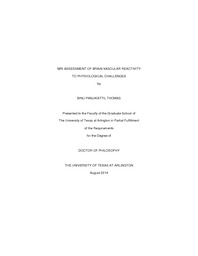
ATTENTION: The works hosted here are being migrated to a new repository that will consolidate resources, improve discoverability, and better show UTA's research impact on the global community. We will update authors as the migration progresses. Please see MavMatrix for more information.
Show simple item record
| dc.contributor.author | Thomas, Binu Panjikattil | en_US |
| dc.date.accessioned | 2014-09-17T17:27:46Z | |
| dc.date.available | 2014-09-17T17:27:46Z | |
| dc.date.issued | 2014-09-17 | |
| dc.date.submitted | January 2014 | en_US |
| dc.identifier.other | DISS-12771 | en_US |
| dc.identifier.uri | http://hdl.handle.net/10106/24692 | |
| dc.description.abstract | With a growing need for specific biomarkers in vascular diseases, the past decade has seen a surging interest in mapping brain vascular reactivity. There is great potential that this CVR mapping can be added to standard clinical MRI protocol, but before this is achieved, we need to better understand the mechanism of BOLD signal change to physiological challenges. A signal increase in the BOLD image is usually seen to CO₂ inhalation, but there are reports of negative CVR as well, i.e. decrease in BOLD signal during inhalation of CO₂ gas. Negative CVR is usually seen in patients with vascular occlusions, which is interpreted as vascular steal i.e. blood being stolen by vascular dilation in the normal regions of the brain. Negative CVR was also reported in normal healthy volunteers, which was also interpreted as vascular steal. To understand the physiologic underpinnings of negative CVR, we performed an Inversion Recovery MRI experiment which showed that negative CVR was because of a volume effect in which blood vessel dilation in the ventricle space displaced the bright CSF which reduced the BOLD signal intensity in the ventricle during CO₂ inhalation. This research from Chapter 2 will impact future interpretations of negative CVR, and also guide intervention studies in patients. CVR in gray matter has been well characterized and understood, but little is known about CVR in WM. Research performed in Chapter 3 helps better understand and characterize WM CVR in terms of its magnitude and temporal characteristics. CVR in the WM was 0.03±0.002 %/mmHg, but was significantly lower than that in the GM: 0.22±0.01 %/mmHg. More strikingly, the WM response showed a temporal delay of 19±3 seconds compared to the GM, which was attributed to the longer time it takes for extravascular CO₂ to change. With age, WM CVR response was found to become greater and faster, which is opposite to the changes seen in the GM. These data suggest that characteristics of WM CVR are different from that of GM and caution should be used when interpreting pathological WM CVR results. Vascular response to inhalation of both O₂ and CO₂ were studied further in WM in Chapter 4. WM was classified into major fiber tracts, cerebral lobes and layers of increasing depth from the cortical surface and vascular response was measured from these regions. One of the most striking findings was that vascular response to O₂ was also considerably delayed in most regions examined, but it was still faster than the CVR to CO₂ inhalation. This difference in delay was attributed to the difference in the mechanism of action of the each gas on brain vasculature. It was also found that as the depth of WM from the cortical surface increases, the magnitude of response to O₂ and CO₂ gas decreases, while delay in vascular response increases. We also report an index of measurement reproducibility between scans for the vascular response in WM to O₂ and CO₂. Research on the application of CVR mapping was performed in Chapter 5 to understand the effect of life-long aerobic exercise on brain vascular health. It was found that exercise preserved blood supply in the brain's default-mode-network against age-related deterioration. On the other hand, its impact on the cerebral vascular system seems to be characterized by a dampening of CO₂ reactivity, possibly because of desensitization effects due to a higher lifetime exposure to CO₂. | en_US |
| dc.description.sponsorship | Lu, Hanzhang | en_US |
| dc.language.iso | en | en_US |
| dc.publisher | Biomedical Engineering | en_US |
| dc.title | MRI Assessment Of Brain Vascular Reactivity To Physiological Challenges | en_US |
| dc.type | Ph.D. | en_US |
| dc.contributor.committeeChair | Lu, Hanzhang | en_US |
| dc.degree.department | Biomedical Engineering | en_US |
| dc.degree.discipline | Biomedical Engineering | en_US |
| dc.degree.grantor | University of Texas at Arlington | en_US |
| dc.degree.level | doctoral | en_US |
| dc.degree.name | Ph.D. | en_US |
Files in this item
- Name:
- Thomas_uta_2502D_12771.pdf
- Size:
- 2.059Mb
- Format:
- PDF
This item appears in the following Collection(s)
Show simple item record


